Intercultural Communication-跨文化沟通
跨文化交际与跨文化交际学详解

3、研究内容
核心问题是:what(是什么)why(为什
么),how(怎么办)
“What”是指来自不同文化背景的人在交际
行为上存在哪些差异;表层差异(现象)
“Why”是指为什么会有这些差异;深层原
因
“How”是指面对这些差异,该如何沟通信 息,实现成功的跨文化交际。
表层差异(现象)
言语行为:口语交际,书面表达 非言语行为:身体语言、体态语、
交际类型
言语交际(口语和书面语) 直接交际 双向交际 点/面 点交际 非言语交际 中介交际 单向交际 点/面 面交际
依是否有固定反应者
依行为源提供信息的情况
有向交际
有意交际
无向交际
无意交际
依反应者选择信息的情况
依交际发生的时间
主动交际
共时交际
被动交际
非共时交际
(二)文化在跨文化交际中的作用
1、“跨文化交际”的定义
4)在角色、对于角色的期望、价值观念、感情和自 我认同方面感受到的混乱;
5)在觉察到文化差异后感到的惊奇、焦虑,甚至厌 恶和气愤; 6)由于不能对付新环境而产生的无能为力的感觉。
蜜月期
哪些人容易产生‚文化休克‛?
1)旅游者,一般不会; 2)短期出访的商人、政府官员、外交官 等,一般较少; 3)留学生和长期在外工作的人员,比较 容易;
理查德森先生:不,不,叫我安迪。我想我们会有 很多生意上的合作的。
楚先生:是的,我希望如此。
理查德森先生(念着楚先生的名片):“楚洪发”。洪 发,明天我一到酒店就打电话给你。
楚先生(微笑):好的,我等你的电话。
Icl培训课件
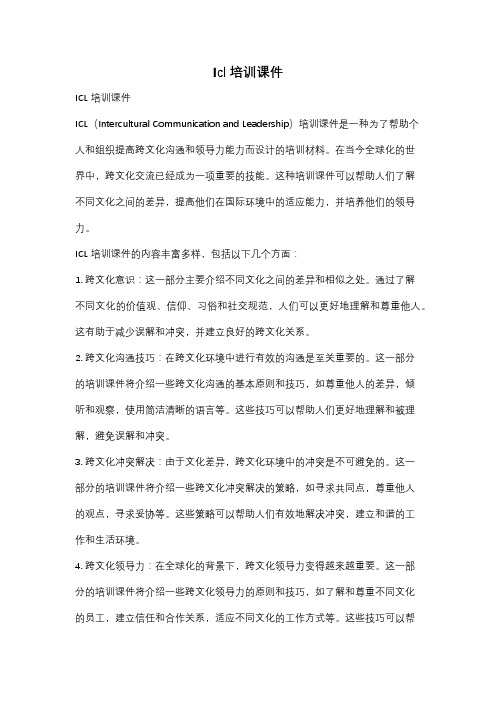
Icl培训课件ICL培训课件ICL(Intercultural Communication and Leadership)培训课件是一种为了帮助个人和组织提高跨文化沟通和领导力能力而设计的培训材料。
在当今全球化的世界中,跨文化交流已经成为一项重要的技能。
这种培训课件可以帮助人们了解不同文化之间的差异,提高他们在国际环境中的适应能力,并培养他们的领导力。
ICL培训课件的内容丰富多样,包括以下几个方面:1. 跨文化意识:这一部分主要介绍不同文化之间的差异和相似之处。
通过了解不同文化的价值观、信仰、习俗和社交规范,人们可以更好地理解和尊重他人。
这有助于减少误解和冲突,并建立良好的跨文化关系。
2. 跨文化沟通技巧:在跨文化环境中进行有效的沟通是至关重要的。
这一部分的培训课件将介绍一些跨文化沟通的基本原则和技巧,如尊重他人的差异,倾听和观察,使用简洁清晰的语言等。
这些技巧可以帮助人们更好地理解和被理解,避免误解和冲突。
3. 跨文化冲突解决:由于文化差异,跨文化环境中的冲突是不可避免的。
这一部分的培训课件将介绍一些跨文化冲突解决的策略,如寻求共同点,尊重他人的观点,寻求妥协等。
这些策略可以帮助人们有效地解决冲突,建立和谐的工作和生活环境。
4. 跨文化领导力:在全球化的背景下,跨文化领导力变得越来越重要。
这一部分的培训课件将介绍一些跨文化领导力的原则和技巧,如了解和尊重不同文化的员工,建立信任和合作关系,适应不同文化的工作方式等。
这些技巧可以帮助领导者更好地发挥他们的领导作用,并促进团队的发展和成功。
5. 跨文化适应能力:在国际化的环境中工作和生活需要一定的适应能力。
这一部分的培训课件将介绍一些提高跨文化适应能力的方法和技巧,如积极主动地学习和了解不同文化,保持开放的心态,培养灵活性和适应性等。
这些方法和技巧可以帮助人们更好地适应和融入不同文化的环境。
总之,ICL培训课件是一种重要的培训材料,可以帮助人们提高跨文化沟通和领导力能力。
跨文化传播学关键术语解读

跨文化传播学关键术语解读跨文化传播学是研究不同文化之间的相互影响、交流和传播过程的学科。
在这个学科领域中,有一些关键术语是至关重要的,对于理解和解释跨文化传播现象具有重要意义。
下面将对其中几个关键术语进行解读,并提供相关参考内容。
1. 跨文化交流(intercultural communication):指不同文化之间的信息传递、理解和共享过程。
跨文化交流是解决文化差异问题和促进跨文化合作的重要手段。
参考内容:文化差异是跨文化交际的核心问题之一。
克里斯滕森(Christopher)指出,文化差异在跨文化交流中表现为语言和非语言差异、态度和价值观差异以及行为和礼仪差异。
在跨文化交际过程中,必须意识到并尊重对方的文化差异,同时培养跨文化沟通能力,以促进有效的交流和理解。
2. 文化霸权(cultural imperialism):指一个文化群体对其他弱势文化群体进行操控和影响的过程。
文化霸权常常伴随着经济、政治和军事力量的不平衡,在全球化的过程中比较常见。
参考内容:文化霸权是一个复杂的现象,常常存在于西方国家文化对其他国家的影响中。
尼尔(Neil)指出,文化霸权是一种意识形态的扩张,通过媒体、教育和商业等手段对其他文化进行塑造和影响。
反对文化霸权的观点认为,文化多样性是保护和发展每个国家独特文化的重要条件。
3. 文化认同(cultural identity):指一个人或群体对自己所属文化的认同感和归属感。
文化认同是个体和群体对自我身份的理解和建构的重要基础。
参考内容:文化认同是一个复杂的概念,常常与个体和社会的需求密切相关。
草本(Clayborne)指出,文化认同通过语言、价值观、习惯等方面的共同体验来建立,并在个体和群体的生活和行为中得以体现。
在跨文化传播中,理解和尊重他人的文化认同是建立和谐关系的重要前提。
4. 跨文化可信度(intercultural credibility):指在跨文化交流中,个体或群体在他人眼中符合期望、可靠可信的程度。
跨文化交际概念

跨文化交际概念“跨文化交际”的英语名称是“cross-cultural communication(或inter-cultural communication)”。
它指本族语者与非本族语者之间的交际,也指任何在语言和文化背景方面有差异的人们之间的交际。
通俗来说就是如果你和外国人打交道(由于存在语言和文化背景的差异),应该注意什么问题,应该如何得体地去交流。
从对外汉语专业的角度,“跨文化交际”的概念可以这样界定:在特定的交际情景中,具有不同的文化背景的交际者使用同一种语言(母语或目的语)进行的口语交际。
它包含以下几个要点:1.交际双方必须来自不同的文化背景文化背景的差异是一个宽泛的概念,既是指不同文化圈之间的差异,也是指同一文化圈内部亚文化之间的差异。
不过立足对外汉语专业,文化差异主要指不同文化圈之间的差异,尤其是中国和欧美国家的文化差异。
因为从跨文化交际的实际情形来看,由于文化背景的差异导致交际失误,容易引起冲突的主要是中国和欧美国家的人际交往。
中国同亚洲地区国家,如日本、韩国以及东南亚一些国家的人际交往,虽然也有文化差异的一面,但要顺利的多,这是因为这些国家与中国同属东方文化圈,彼此之间在文化取向和交际规范方面有很多相通的地方。
[1]2.交际双方必须使用同一种语言交际这是显而易见的,假如一方使用一种语言,而另一方使用另外一种不同的语言,交际是无法进行的。
但是,既然交际的双方来自不同的文化背景,又要使用同一种语言,那么用来交际的语言对一方来说是母语,而对另一方来说必然是第二语言(习得的“目的语”)。
比如一个中国人与一个美国人交谈,他们可以选择使用汉语,也可以选择使用英语,这样他们就可以用同一种语言直接交际,而不需要通过翻译这个中间环节。
这样界定的着眼点也是由对外汉语专业的特点决定的。
3.交际双方进行的是实时的口语交际跨文化交际的途径多种多样。
可以是语言符号的交际,也可以是非语言符号的交际,如商品、画报、实物、影像、演出到其他物化形式符号的交际;可以是现场的双向交际,也可以是通过媒介的单向交际,如电视、广播、报刊、广告等传播方式的交际;可以是口语交际,也可以是书面交际,如信函、公文等的来往。
会通名词解释(一)

会通名词解释(一)会通的定义会通(huì tōng)是指能够沟通、交流、理解和把握不同领域、学科、行业等之间的知识、技术、经验和观念的能力。
具备会通能力的人可以快速适应新环境,处理复杂问题,跨界合作,创造创新性的解决方案。
相关名词以下是与“会通”概念相关的一些名词:1. 多学科交叉多学科交叉(interdisciplinarity)是指不同学科之间的融合和交叉。
通过多学科交叉,不同学科的知识和方法可以互相借鉴,从而促进创新和新的学科发展。
例子:神经科学是一门涉及生物学、心理学、物理学等多学科交叉的科学领域。
神经科学研究人类大脑的结构和功能,并且探索与认知、行为相关的机制。
2. 跨界合作跨界合作(cross-disciplinary collaboration)是指不同领域、行业或组织之间的合作与协作。
通过跨界合作,不同领域的专业人士可以共同解决复杂问题,创造更好的创新性解决方案。
例子:在城市规划领域,城市设计师、交通工程师、环境专家等可以进行跨界合作,共同设计宜居、可持续发展的城市。
3. 全栈能力全栈能力(full stack capability)是指能够熟练掌握一个或多个领域的技术和知识,包括前端开发、后端开发、数据库管理等。
具备全栈能力的人可以在多个领域进行全面的工作。
例子:全栈工程师可以同时负责网站的前端设计、后端开发、数据库管理和服务器配置等。
他们具备多个领域的技术能力,可以在项目中发挥更广泛的作用。
4. 跨文化沟通跨文化沟通(intercultural communication)是指在不同文化背景下进行有效的交流和理解。
跨文化沟通需要了解和尊重不同文化的差异,避免误解和冲突。
例子:在国际商务中,进行跨文化沟通是非常重要的。
商务人士需要了解不同文化的礼仪和价值观,以确保合作伙伴之间的准确理解和良好关系。
5. 跨界思维跨界思维(cross-boundary thinking)是指超越传统思维框架、领域或行业的思考方式。
新编跨文化交际英语教程 复习总结
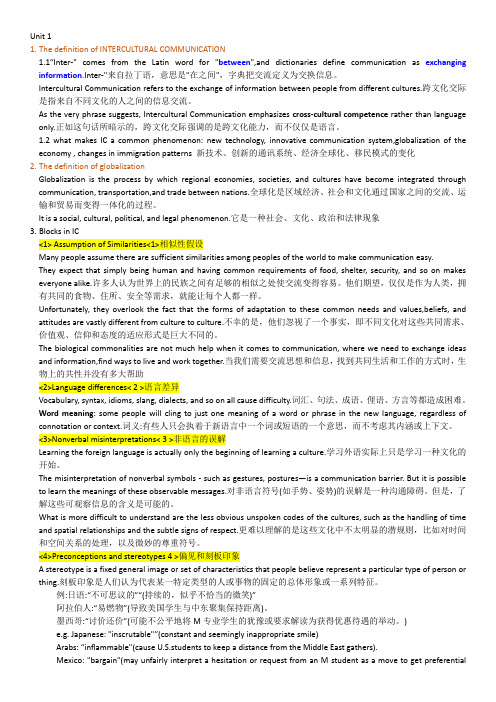
Unit 11.The definition of INTERCULTURAL COMMUNICATION1.1“Inter-" comes from the Latin word for "between",and dictionaries define communication as exchanging information.Inter-"来自拉丁语,意思是"在之间",字典把交流定义为交换信息。
Intercultural Communication refers to the exchange of information between people from different cultures.跨文化交际是指来自不同文化的人之间的信息交流。
As the very phrase suggests, Intercultural Communication emphasizes cross-cultural competence rather than language only.正如这句话所暗示的,跨文化交际强调的是跨文化能力,而不仅仅是语言。
1.2 what makes IC a common phenomenon: new technology, innovative communication system,globalization of the economy , changes in immigration patterns 新技术、创新的通讯系统、经济全球化、移民模式的变化2.The definition of globalizationGlobalization is the process by which regional economies, societies, and cultures have become integrated through communication, transportation,and trade between nations.全球化是区域经济、社会和文化通过国家之间的交流、运输和贸易而变得一体化的过程。
跨文化交际学
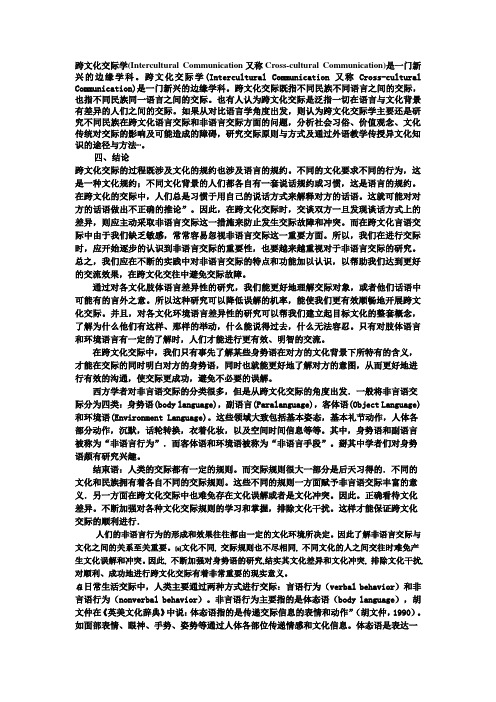
跨文化交际学(Intercultural Communication又称Cross-cultural Communication)是一门新兴的边缘学科。
跨文化交际学(Intercultural Communication又称Cross-cultural Communication)是一门新兴的边缘学科。
跨文化交际既指不同民族不同语言之间的交际,也指不同民族同一语言之间的交际。
也有人认为跨文化交际是泛指一切在语言与文化背景有差异的人们之间的交际。
如果从对比语言学角度出发,则认为跨文化交际学主要还是研究不同民族在跨文化语言交际和非语言交际方面的问题,分析社会习俗、价值观念、文化传统对交际的影响及可能造成的障碍,研究交际原则与方式及通过外语教学传授异文化知识的途径与方法⋯。
四、结论跨文化交际的过程既涉及文化的规约也涉及语言的规约。
不同的文化要求不同的行为,这是一种文化规约;不同文化背景的人们都各自有一套说话规约或习惯,这是语言的规约。
在跨文化的交际中,人们总是习惯于用自己的说话方式来解释对方的话语。
这就可能对对方的话语做出不正确的推论”。
因此,在跨文化交际时,交谈双方一旦发现谈话方式上的差异,则应主动采取非语言交际这一措施来防止发生交际故障和冲突。
而在跨文化言语交际中由于我们缺乏敏感,常常容易忽视非语言交际这一重要方面。
所以,我们在进行交际时,应开始逐步的认识到非语言交际的重要性,也要越来越重视对于非语言交际的研究。
总之,我们应在不断的实践中对非语言交际的特点和功能加以认识,以帮助我们达到更好的交流效果,在跨文化交往中避免交际故障。
通过对各文化肢体语言差异性的研究,我们能更好地理解交际对象,或者他们话语中可能有的言外之意。
所以这种研究可以降低误解的机率,能使我们更有效顺畅地开展跨文化交际。
并且,对各文化环境语言差异性的研究可以帮我们建立起目标文化的整套概念,了解为什么他们有这样、那样的举动,什么能说得过去,什么无法容忍。
跨文化交际能力的培养

跨文化交际能力的培养跨文化交际(intercultural communication 或cross-cultural communication),是指本族语者与非本族语者之间的交际,也指任何在语言和文化背景方面有差异的人们之间的交际。
由于不同的民族所处的生态、物质、社会及宗教等环境不同,因而各自的语言环境产生了不同的语言习惯、社会文化、风土人情等等,也造成了人们说话方式或习惯不尽相同。
因此,在交流中,人们总喜欢用自己的说话方式来解释对方的话语,这就可能对对方的话语做出不准确的推论,从而产生冲突和障碍。
跨文化交际能力就是针对文化冲突提出来的,它是一种在理解、掌握外国文化知识与交际技能的基础上,灵活处理跨文化交际中出现的实际问题的能力。
跨文化交际能力是一个新概念,关于它的界定仍在不断讨论中。
布卢姆提出它应由态度(attitude)、知识(knowledge)与技能(skill)三方面构成。
1、态度。
跨文化交际能力概念中所包含的“态度”,主要是指对交际对象不同于自我的观念、价值观与行为的看法和表现。
为达到互相沟通的目的,交际者需要对交际对象的社会文化持有好奇与开放的心态,有意识地发现其它文化的特征,并主动通过与交际对象的接触与社交加深对它们的认识。
2、知识。
交际场合需要的社会文化知识包括两方面:一是本人与交际对象的国家或民族的社会文化知识;二是在交际过程中如何根据实际需要恰如其分地运用已学的社会文化准则控制交际进程的知识。
3、技能。
学习者需要掌握的社会文化技能包括两方面:第一种技能是在接受信息以后,根据已掌握的社会文化知识对信息进行分析以达到理解与说明的目的;第二种技能是在此基础上发现新信息,并将它们连同第一种技能处理的(即已理解的)信息一起提供交际使用。
这两种技能的结合便使已掌握的社会文化知识得以运用到交际的实际中去。
现行的高中英语教材中,蕴涵西方文化的内容比比皆是,这为英语教学中的跨文化渗透提供了一个很好的平台。
跨文化交际》_名词解释

跨文化交际》_名词解释名词解释1.Intercultural communication refers to communication betweenpeople whose culture perceptions and symbol systems are distinct enough to alter the communication event.跨文化交际:指拥有不同文化认知和符号体系的人文之间进行的交际。
2.Culture is a learned set of shared interpretations about beliefs,values, and norms, which affect the behavior of a relatively large group of people.文化是习得的一套关于信仰,价值观,规范的公认的解释,这些信仰,价值观,规范对相当大人类群体的行为产生影响。
3.Culture identity refers to one’s sense of belonging to aparticular culture or ethnic group.文化身份:指有意识地把自己归为某一特定文化或种族群体。
4.Subculture are formed by groups of people possessingcharacteristic traits that set apart and distinguish them from others within a larger society or dominant culture.亚文化:具有能在更大的一个社会范围内或主流文化中使自己有别于他人的特点的人类群体所形成的文化。
5.Norms are culturally ingrained principles of correct andincorrect behaviors which, if broken carry a form of overt or covert penalty.规范指的是正确和不正确行为根深蒂固的文化原则,这种不正确的行为一旦发生,就意味着一种显性或隐性的处罚。
跨文化交际(一)

What about the result?
Japan in the Second World War
Is this related to this course?
Yes!
“默杀”
“默杀”(mokusatsu)在日文中到底
是什么意思?
各种资料说法不一。不过集中到一点,就是说“默杀” 有两个意思:一个是“无视”(“不理睬”、“置之不 理”),另一个是“不予评论”。 曾经有一种颇为流行的说法,称当时日本政府对此最后 通牒的态度其实是“不予评论”,而非“不予理睬”, 更非“拒绝”。由此更引申为同盟国“误译”,最后导 致日本成为迄今为止世界上唯一的原子弹受害国。 还有人把对“默杀”的“误译”说成是英日文间的对应 词问题,说是日文中的“默杀”在英文中没有完全对等 的词。据美国作家托兰的《日本帝国的衰亡》所写,铃 木后来曾对其子说,他的本意是要说“不予评论”,但 日文里却没有对应的词汇。 也有人认为即便真有两种解释,认为也没有理由将“默 杀”译成“不予评论”。因为铃木讲话中的“翻版”和 “没有重大价值”本身就是评论了,后面如果加上“不 予评论”,岂不自相矛盾? “默杀”(mokusatsu)是一个含糊的词,而广岛的原子弹 又给它赋予了沉重的含义。 仅仅是因为一个词的理解上 的差异造成的沟通上的障碍,而使数十万人失去了生命.
The introduction of the course
Reference books
市场价:¥28.90
市场价:mmunication 跨文化交际
Question:
What is IC(Intercultural Communication)?
Japan in the Second World War
跨文化交际的英文表达
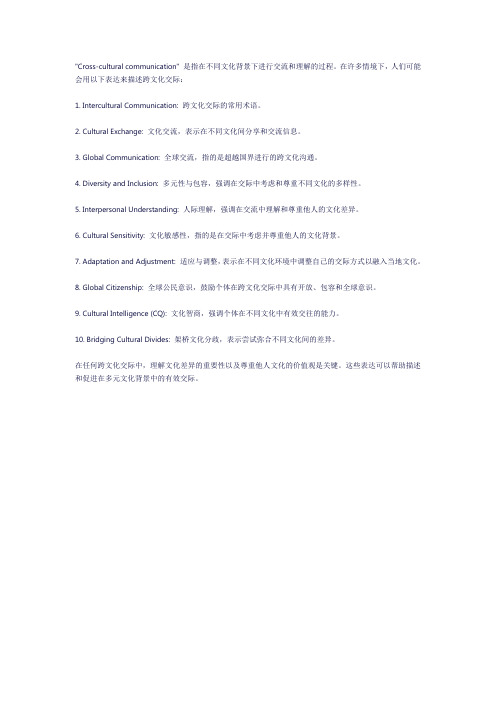
"Cross-cultural communication" 是指在不同文化背景下进行交流和理解的过程。
在许多情境下,人们可能会用以下表达来描述跨文化交际:
1. Intercultural Communication: 跨文化交际的常用术语。
2. Cultural Exchange: 文化交流,表示在不同文化间分享和交流信息。
3. Global Communication: 全球交流,指的是超越国界进行的跨文化沟通。
4. Diversity and Inclusion: 多元性与包容,强调在交际中考虑和尊重不同文化的多样性。
5. Interpersonal Understanding: 人际理解,强调在交流中理解和尊重他人的文化差异。
6. Cultural Sensitivity: 文化敏感性,指的是在交际中考虑并尊重他人的文化背景。
7. Adaptation and Adjustment: 适应与调整,表示在不同文化环境中调整自己的交际方式以融入当地文化。
8. Global Citizenship: 全球公民意识,鼓励个体在跨文化交际中具有开放、包容和全球意识。
9. Cultural Intelligence (CQ): 文化智商,强调个体在不同文化中有效交往的能力。
10. Bridging Cultural Divides: 架桥文化分歧,表示尝试弥合不同文化间的差异。
在任何跨文化交际中,理解文化差异的重要性以及尊重他人文化的价值观是关键。
这些表达可以帮助描述和促进在多元文化背景中的有效交际。
跨文化交际理解英语作文

跨文化交际理解英语作文英文回答:Intercultural communication, the exchange of information, ideas, and feelings between individuals from different cultural backgrounds, poses unique challenges and opportunities in the era of globalization. As the world becomes increasingly interconnected, individuals must develop intercultural competence, the ability to communicate effectively and respectfully across cultures.Effective intercultural communication requires an understanding of the cultural context of communication.This includes knowledge of cultural norms, values, beliefs, and communication styles. For example, in some cultures, it is considered polite to maintain eye contact while speaking, while in other cultures, it is considered disrespectful. By understanding the cultural context, communicators can avoid misunderstandings and build rapport.In addition to cultural understanding, effective intercultural communication also requires empathy and flexibility. Empathy is the ability to understand and share the feelings of others. By showing empathy, communicators can build trust and create a cooperative atmosphere. Flexibility is the ability to adapt one's communication style to the needs of the situation. For example, in a formal setting, it might be appropriate to use a more formal communication style, while in a casual setting, a more informal style might be more appropriate.Finally, effective intercultural communication requires a willingness to learn and grow. Individuals should be open to new experiences and perspectives, and they should be willing to challenge their own assumptions. By embracing the principles of effective intercultural communication, individuals can build strong relationships, foster understanding, and create a more just and equitable world.中文回答:跨文化交际是不同文化背景的个人之间信息、思想和情感的交流,在全球化的时代里带来了独特的挑战和机遇。
idea translation单词本
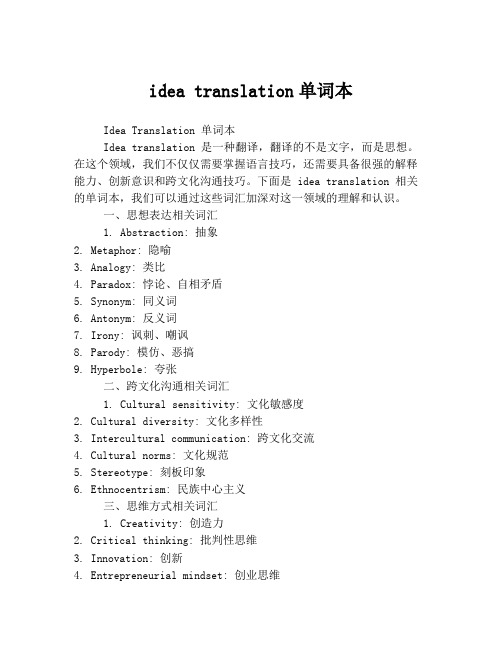
idea translation单词本Idea Translation 单词本Idea translation 是一种翻译,翻译的不是文字,而是思想。
在这个领域,我们不仅仅需要掌握语言技巧,还需要具备很强的解释能力、创新意识和跨文化沟通技巧。
下面是 idea translation 相关的单词本,我们可以通过这些词汇加深对这一领域的理解和认识。
一、思想表达相关词汇1. Abstraction: 抽象2. Metaphor: 隐喻3. Analogy: 类比4. Paradox: 悖论、自相矛盾5. Synonym: 同义词6. Antonym: 反义词7. Irony: 讽刺、嘲讽8. Parody: 模仿、恶搞9. Hyperbole: 夸张二、跨文化沟通相关词汇1. Cultural sensitivity: 文化敏感度2. Cultural diversity: 文化多样性3. Intercultural communication: 跨文化交流4. Cultural norms: 文化规范5. Stereotype: 刻板印象6. Ethnocentrism: 民族中心主义三、思维方式相关词汇1. Creativity: 创造力2. Critical thinking: 批判性思维3. Innovation: 创新4. Entrepreneurial mindset: 创业思维5. Systems thinking: 系统思维6. Design thinking: 设计思维四、技术工具相关词汇1. Artificial Intelligence (AI): 人工智能2. Machine Translation (MT): 机器翻译3. Computer-Aided Translation (CAT): 计算机辅助翻译4. Translation Memory (TM): 翻译记忆库5. Post-Editing: 后编辑以上单词本并非穷尽所有涉及 idea translation 的内容,但是它们可以为我们开拓思路和方法提供很好的帮助。
跨文化沟通

• • • • • • •
(四)价值观 美国人认同竞争,日本人认为竞争会导致不和谐 美国人喜欢标新立异出风头,中国人喜欢随大流 美国人直率、外露,中国人委婉含蓄 美国人认为成功归因为个人努力,英法归因阶层关系 美国重个人主义,日本人集体主义 美国人安静意味着工作,日本人边聊天边干活
• 年龄观:东方敬老;西方重视青年 • 个人观:东方无我;从众,西方,自我,竞争欲望烈 • 成就观:东方守业,重集体精神;西方,创业,个人利益 为先
摩西十诫
除了耶和华不可再信奉别的神、 不可雕刻崇拜任何偶像 不可妄称耶和华的尊名 当记念安息日守为圣日 孝敬父母 不可杀人 不可奸淫 不可偷盗、 不可做伪证 不可贪恋他人财物
几个国家的文化特点
国别 美国 英国 文化特点 热情、主动、礼貌、诚恳、简洁、守时、好客、注重餐桌礼仪、着 装礼仪、注重个人隐私权 绅士风度、礼貌、尊重女性,注重穿着、好以貌取人、守时、社交 场合禁烟、爱小礼品、白色花的死亡蕴意、公务忌讳谈个人私事、 家事、婚丧、年龄、职业、收入、宗教,忌讳13 爱好社交、诙谐幽默、天性浪漫、善于开玩笑、高谈阔论、善于冒 险、渴求自由、纪律性差、讲究服饰礼仪、忌讳13和星期五、爱好 艺术品味的礼物
第二节 东西方文化的比较(二)
比较项目 学习目的 时间观念 东方 陶冶心灵,提升自我,超越现 实 慎独 自然节奏、长期时间观念,节 省、思考问题易受未来影响 西方 认识世界,改变世界 固定节奏,钟表的节奏、短期 时间观念,易自我放纵、不愿 为未来准备和储蓄 直接明了、富有逻辑性、低情 境文化沟通 问候:直接通话、手写便笺、 卡片、小礼物 从小到大,再到小
• 几个国家的商务谈判特点
国别 美国 谈判关系的建立 公事公办,商业关系第 一,不重个人 决策程序 个人决策为 主 时间观念 强。强调效率 沟通方式 直率坦诚 真挚热情 对合同态度 一定形成法律 文本件
跨文化交际复习考试题及答案
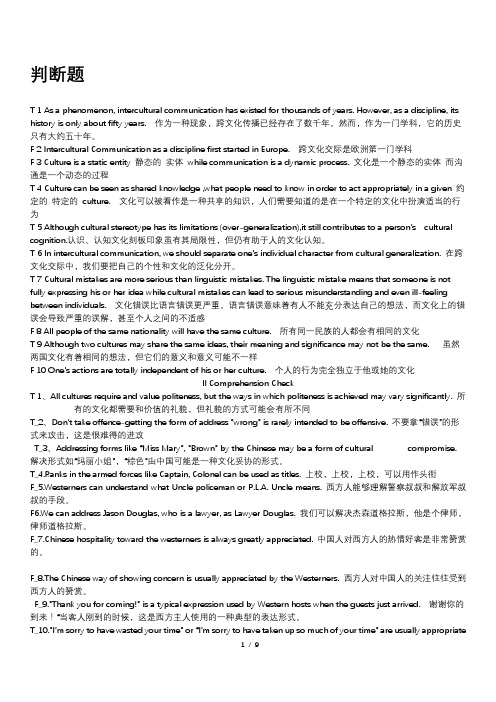
判断题T 1 As a phenomenon, intercultural communication has existed for thousands of years. However, as a discipline, its history is only about fifty years. 作为一种现象,跨文化传播已经存在了数千年。
然而,作为一门学科,它的历史只有大约五十年。
F 2 Intercultural Communication as a discipline first started in Europe. 跨文化交际是欧洲第一门学科F 3 Culture is a static entity 静态的实体while communication is a dynamic process. 文化是一个静态的实体而沟通是一个动态的过程T 4 Culture can be seen as shared knowledge ,what people need to know in order to act appropriately in a given 约定的特定的culture. 文化可以被看作是一种共享的知识,人们需要知道的是在一个特定的文化中扮演适当的行为T 5 Although cultural stereotype has its limitations (over-generalization),it still contributes to a person’s cultural cognition.认识、认知文化刻板印象虽有其局限性,但仍有助于人的文化认知。
T 6 In intercultural communication, we should separate one’s individual character from cultural generalization. 在跨文化交际中,我们要把自己的个性和文化的泛化分开。
- 1、下载文档前请自行甄别文档内容的完整性,平台不提供额外的编辑、内容补充、找答案等附加服务。
- 2、"仅部分预览"的文档,不可在线预览部分如存在完整性等问题,可反馈申请退款(可完整预览的文档不适用该条件!)。
- 3、如文档侵犯您的权益,请联系客服反馈,我们会尽快为您处理(人工客服工作时间:9:00-18:30)。
Intercultural Communication: High- and Low-Context CulturesAnthropologist Edward Hall founded the field of intercultural communication in 1959 with his book The Silent Language. The book was originally intended for the general public, but it sparked academic research in intercultural communication and fueled interest in subjects like nonverbal communication, according to Keio Communication Review.Hall defines intercultural communication as a form of communication that shares information across different cultures and social groups. One framework for approaching intercultural communication is with high-context and low-context cultures, which refer to the value cultures place on indirect and direct communication.High-Context CulturesA high-context culture relies on implicit communication and nonverbal cues. In high-context communication, a message cannot be understood without a great deal of background information. Asian, African, Arab, central European and Latin American cultures are generally considered to be high-context cultures.High-context cultures often di splay the following tendencies, according to C.B. Halverson’s book Cultural Context Inventory.Association: Relationships build slowly and depend on trust. Productivity depends on relationships and the group process. An individual’s identity is rooted in groups (family, culture, work). Social structure and authority are centralized.Interaction: Nonverbal elements such as voice tone, gestures, facial expression and eye movement are significant. Verbal messages are indirect, and communication is seen as an art form or way of engaging someone. Disagreement is personalized, and a person is sensitive to conflict expressed in someone else’s nonverbal communication.Territoriality: Space is communal. People stand close to each other and share the same space. Temporality: Everything has its own time, and time is not easily scheduled. Change is slow, and time is a process that belongs to others and nature.Learning: Multiple sources of information are used. Thinking proceeds from general to specific. Learning occurs by observing others as they model or demonstrate and then practicing. Groups are preferred, and accuracy is valued.Low-Context CulturesA low-context culture relies on explicit communication. In low-context communication, more of the information in a message is spelled out and defined. Cultures with western European roots, such as the United States and Australia, are generally considered to be low-context cultures. Low-context cultures often display the following tendencies, according to Halverson.Association: Relationships begin and end quickly. Productivity depends on procedures and paying attention to the goal. The identity of individuals is rooted in themselves and their accomplishments. Social structure is decentralized.Interaction:Nonverbal elements are not significant. Verbal messages are explicit, and communication is seen as a way of exchanging information, ideas and opinions. Disagreement is depersonalized; the focus is on rational (not personal) solutions. An individual can be explicit abou t another person’s bothersome behavior.Territoriality: Space is compartmentalized. Privacy is important, so people stand farther apart. Temporality: Events and tasks are scheduled and to be done at particular times. Change is fast, and time is a commodity to be spent or saved. One’s time is one’s own.Learning:One source of information is used. Thinking proceeds from specific to general. Learning occurs by following the explicit directions and explanations of others. Individual orientation is preferred, and speed is valued.High and low context cultures usually correspond with polychronic and monochronic cultures respectively. The table below shows some general preferences of people from high context and low context cultures.Communication Dynamics in High- and Low-Context CulturesCultural differences shape every aspect of global communication, says Forbes contributor Carol Kinsey Goman. This helps explain why people in Japan (a high-context culture) prefer face-to-face communication over electronic technology favored by other industrialized countries like the United States, Canada, the United Kingdom and Germany (low-context cultures).High-context cultures also prefer personal bonds and informal agreements over meticulously worded legal documents. They “are looking for meaning and understanding in what is not said —in body language, in silences and pauses, and in relationships and empathy,” Goman says. Meanwhile, low-context cultures “place emphasis on sending and receiving accurate messages directly, and by being precise with spoken or written words,” she explains. U.S. business leaders often fall into a communication trap by disregarding the importance of building and maintaining personal relationships when interacting with people from high-context cultures.People should also watch for differences within high- and low-context cultures. This classification is an oversimplification, according to A.C. Krizan and others in the book Business Communication. “For example, although American culture is classified as l ow context, communication among family members tends to be high context,” they write. “Family relationships and members’ high level of shared experiences require fewer words because of mutual understandings.”On the other hand, communication between two businesspersons from a low-context culture tends to be more specific and direct. Attention focuses more on what is said than relationships. In China or Japan, words receive less attention than relationships, mutual understandings and nonverbal body language.Clearly, it’s important for a multinational organization to know the difference between high and low context cultures. A full understanding of these differences will effectively improve both outward, client-focused communication as well as inter-business relationships.Will a company in Japan appreciate your attempts to get right to the point? Will a German company become bored if you talk around a subject, instead of directly addressing it? Know your audience and their cultural standing, and your message will never get lost.。
